15 examples of successful loyalty programs to learn from in 2025
By Laura Ojeda Melchor●6 min. read●Jul 22, 2025
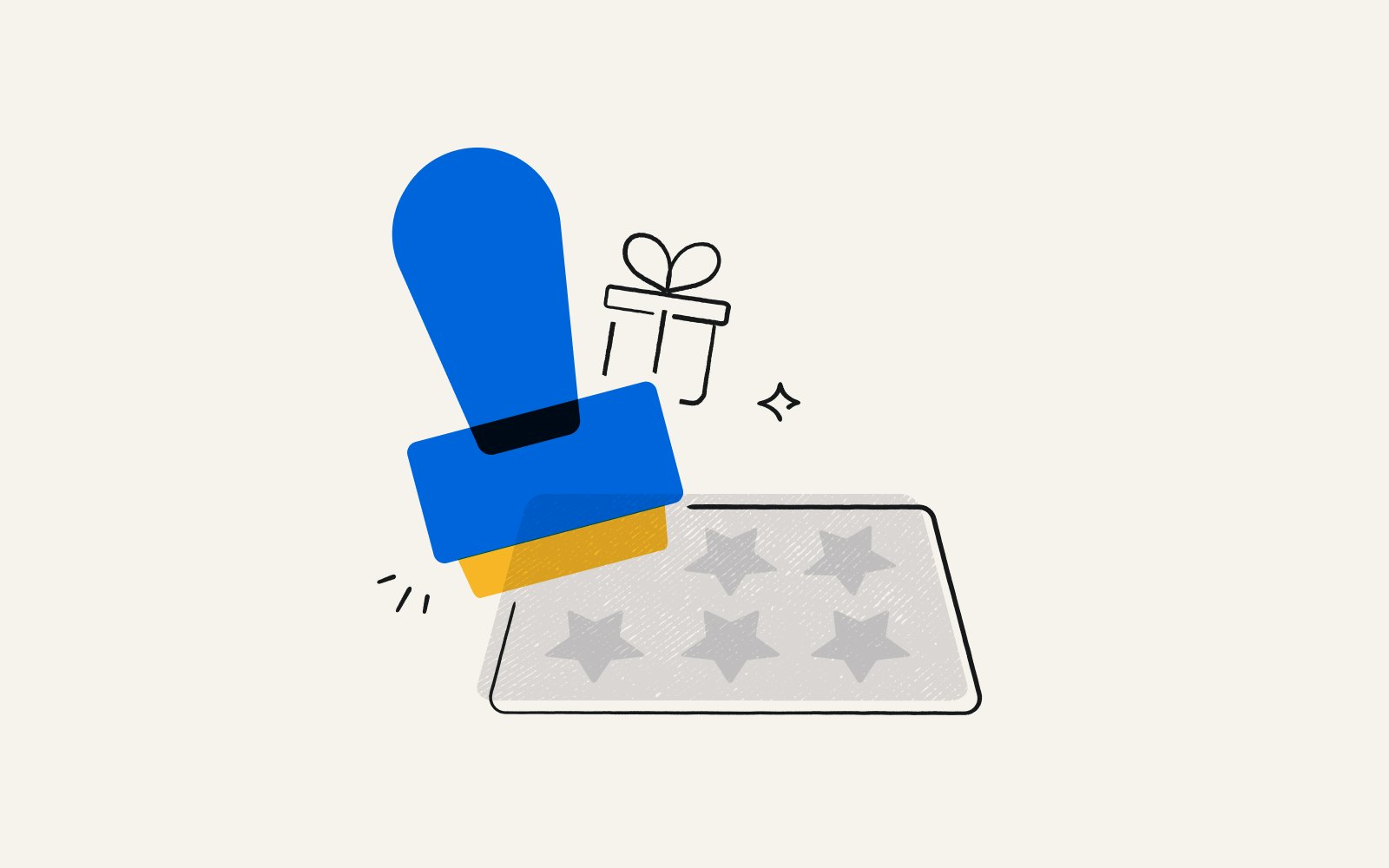
Loyalty programs aren’t just nice to have. In 2025, they’re essential for driving repeat business and long-term customer value.
Case in point: Brands like Starbucks and Sephora get the majority of their US sales from loyalty members using thoughtful personalization and real-time rewards.
This article dives into 15 standout examples of loyalty programs and break down what makes each one work.
What makes a customer loyalty program successful?
There are dozens of ways to structure a successful loyalty program. Whether you reward customers with points that add up to free products, cashback on purchases, or access to exclusive benefits, the following factors impact how successful your program will be.
Memorable branding: Strong branding creates long-term customers. Longterm customers create staggering business growth: on average, companies with strong brand loyalty deliver 5x greater shareholder value compared to their peers.
Strategic marketing: Consider where you choose to advertise your loyalty program, when you present the program to customers, and how you talk about your rewards.
Simple user experience: The simpler it is for customers to earn, track, and cash out on loyalty rewards, the better.
Personalized offers: Personalization matters. A whopping 86% of consumers say that personalization influences their purchases.
Reward frequency: Offer incentives at a frequency that's profitable for your business but still enticing for customers.
How effective are loyalty programs?
A 2020 McKinsey survey found that customers are 30% more likely to spend more money on the brand after joining free loyalty programs. That statistic jumps to 60% for paid loyalty programs.
On top of that, Accenture Interactive found that loyalty program customers generate 12 to 18% more revenue for retailers compared to non-members.
15 examples of successful loyalty rewards programs
Effective loyalty programs allow customers to earn free products, cashback, discounts, and other perks based on repeat purchases. Here are 15 successful examples for inspiration in 2025.
Points-based customer loyalty programs
1. Starbucks
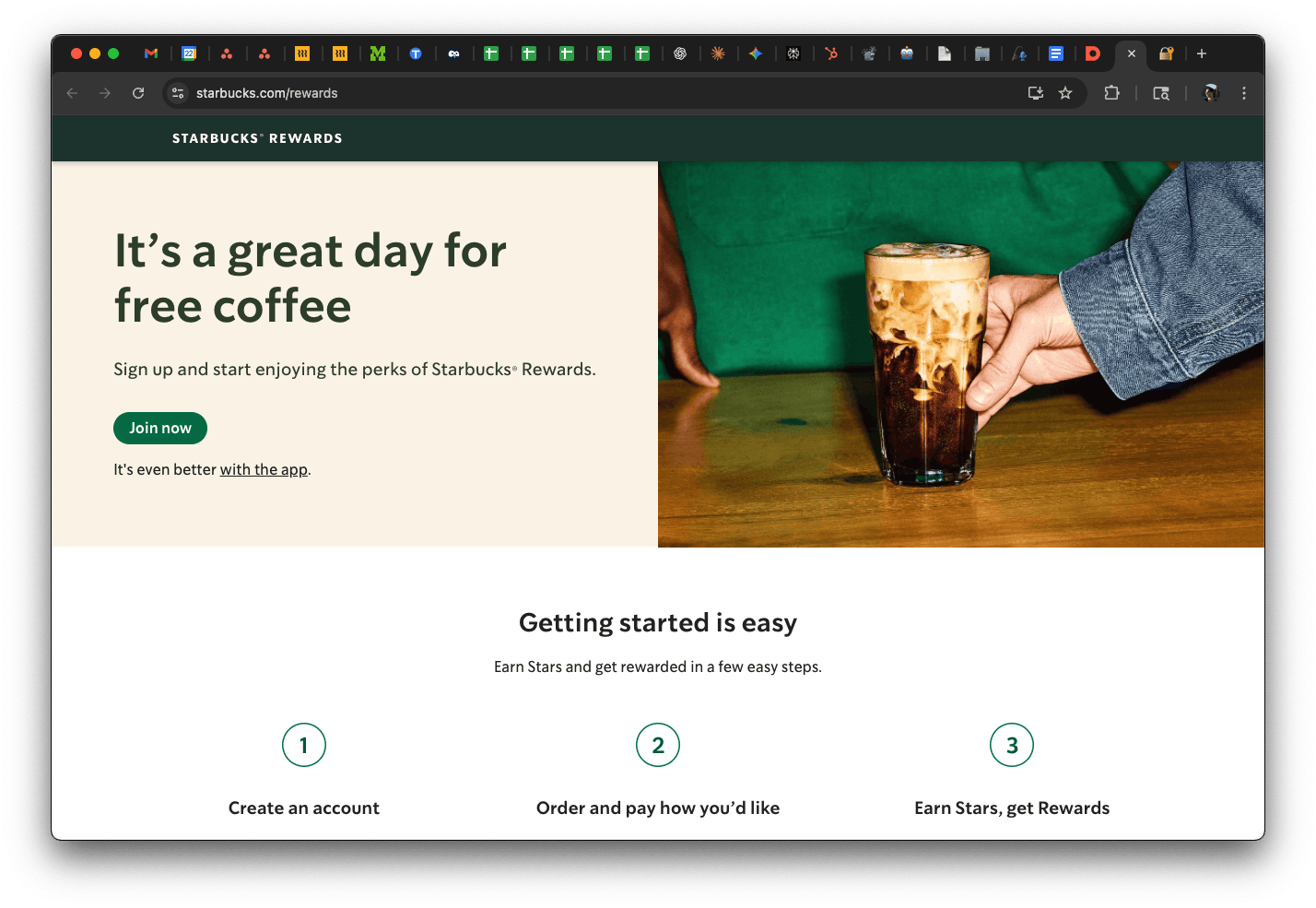
Starbucks Rewards is the quintessential loyalty reward program success story. Its 30 million+ members generated 57% of the company’s revenue in the second quarter of 2023. Customers earn Stars for every purchase, which they can redeem for rewards like a specialty drink or a signature Starbucks cup.
Starbucks also gives members double the points if they preload their loyalty cards with funds. It’s a clever tactic that secures the company a significant cash advance.
What makes it work:
High-frequency, habit-based earning. Coffee is a daily ritual for many. Starbucks Rewards turns that habit into repeat engagement.
Preload incentives. Encouraging customers to preload funds guarantees future spend and gives the coffee chain a cash flow advantage.
Personalization and convenience. Targeted offers, birthday rewards, and mobile ordering make the program easy to use and relevant to consumer preferences.
Best for:
Brands with frequent purchases and mobile-first transactions, especially in food, beverage, or quick-service retail.
Key takeaway:
When a loyalty program is tied to daily behavior and offers real value to customers, it can drive emotional connection and measurable business impact.
2. American Airlines
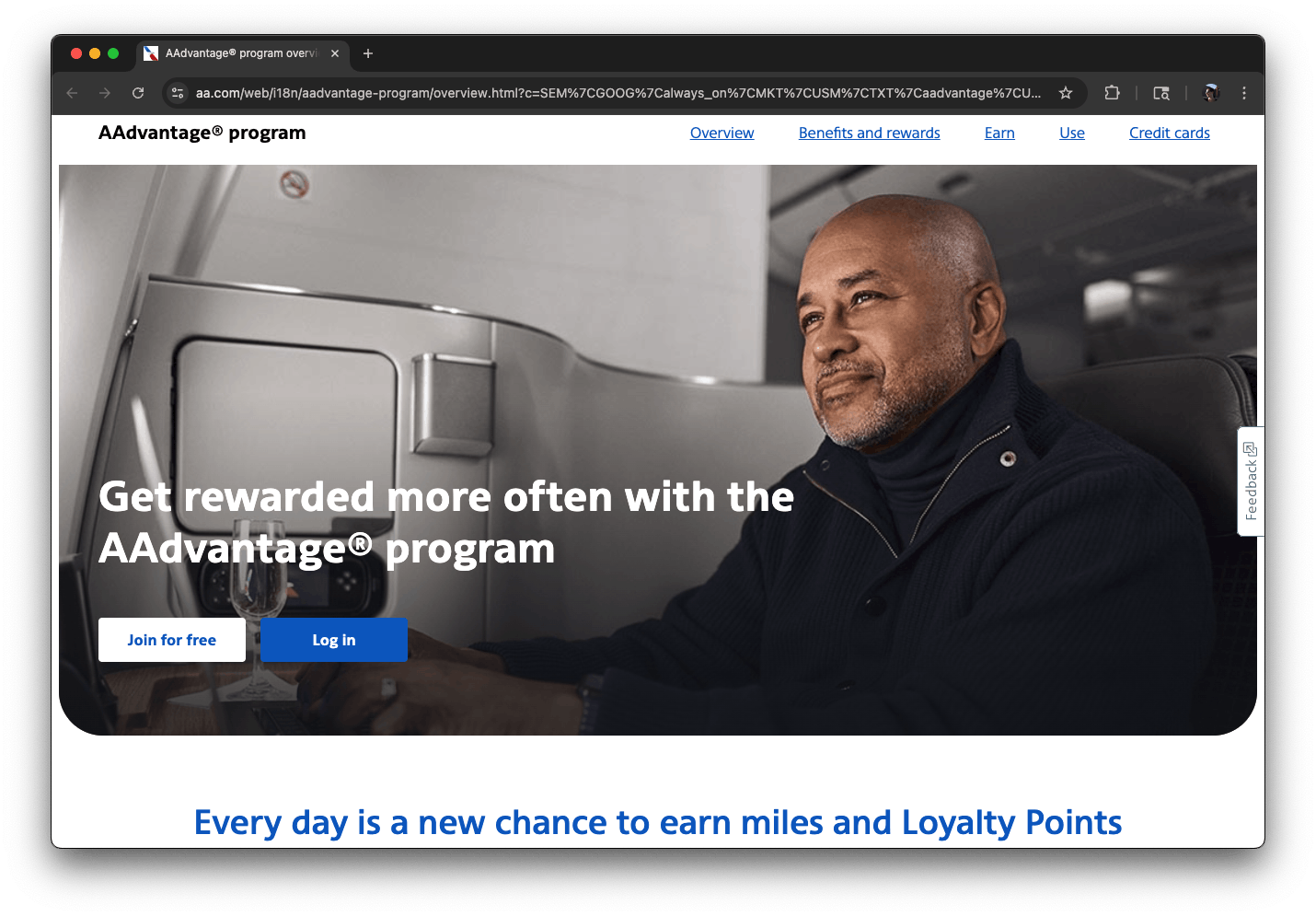
American Airlines’ AAdvantage was one of the first frequent-flyer loyalty programs in the world. And it’s still going strong 40+ years after its inception.
Customers earn loyalty rewards by:
Flying on American Airlines or its partners
Making purchases with an AAdvantage credit card
Shopping with American Airlines' partners
Members collect miles and loyalty points that add up to free travel. With AAdvantage, fliers also get exclusive promotions and board earlier than non-members.
Earning enough miles for a free trip or special status is so enticing that people will opt to book with American Airlines over another airline, sometimes paying more or taking a less convenient route.
This model is so effective for airlines largely because the cost of their service is high. It’s harder for people to miss out on miles or points that could save them hundreds in travel costs or give them upgrades for a whole year.
What makes it work:
High-value reward potential. The ability to earn free flights or elite status makes members more likely to stay loyal.
Multiple earning channels. Members rack up points not just by flying, but also by using branded credit cards and shopping with partners.
Tiered structure with strong perks. Status tiers unlock upgrades, free checked bags, and priority check-in.
Best for:
High-cost, lower-frequency industries like airlines, travel, and luxury services where the rewards can significantly influence consumer decision-making.
Key takeaway:
When rewards are substantial and emotionally tied to experiences like travel, customers are more willing to remain loyal, even in a competitive market.
3. Sephora
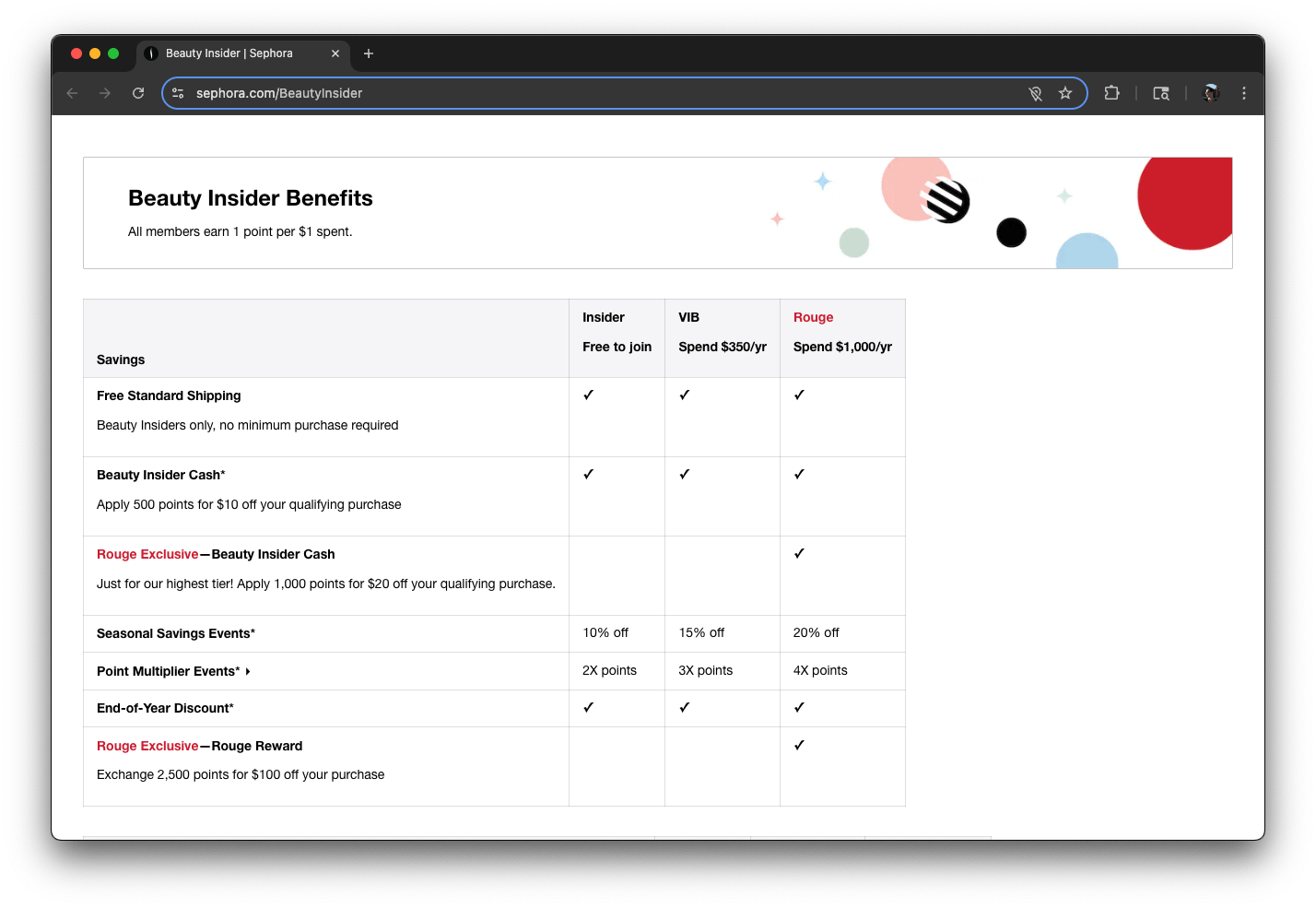
Launched in 2007, Sephora’s Beauty Insider now boasts 31 million members. Beauty Insiders can redeem points for samples in Sephora's branded Rewards Bazaar and get a free birthday gift, which can be anything from 250 bonus points to a makeup set.
Sephora’s loyalty program is so successful that its loyalty members drive 80% of the company’s sales.
What’s unique about Sephora’s program is that it’s regularly updated. Rather than making large changes, the retailer consistently adds and changes perks across its three tiers (Rouge, VIB, and Insider) to attract new members and delight existing ones.
What makes it work:
Tiered structure tied to spend. Sephora encourages customers to spend more to reach VIB and Rouge levels, where perks become increasingly exclusive.
Flexible rewards and choice. Members can redeem points for products, samples, or bonus points based on their preferences.
Consistent, thoughtful updates. The program is regularly refreshed with new perks and limited-time rewards, keeping things fresh without disrupting the user experience.
Best for:
Retailers in beauty, fashion, or luxury goods that want to build long-term relationships with high-value customers.
Key takeaway:
Loyalty programs don’t need constant overhauls. Consistent refinements can effectively improve the user experience.
4. Dunkin’ Donuts
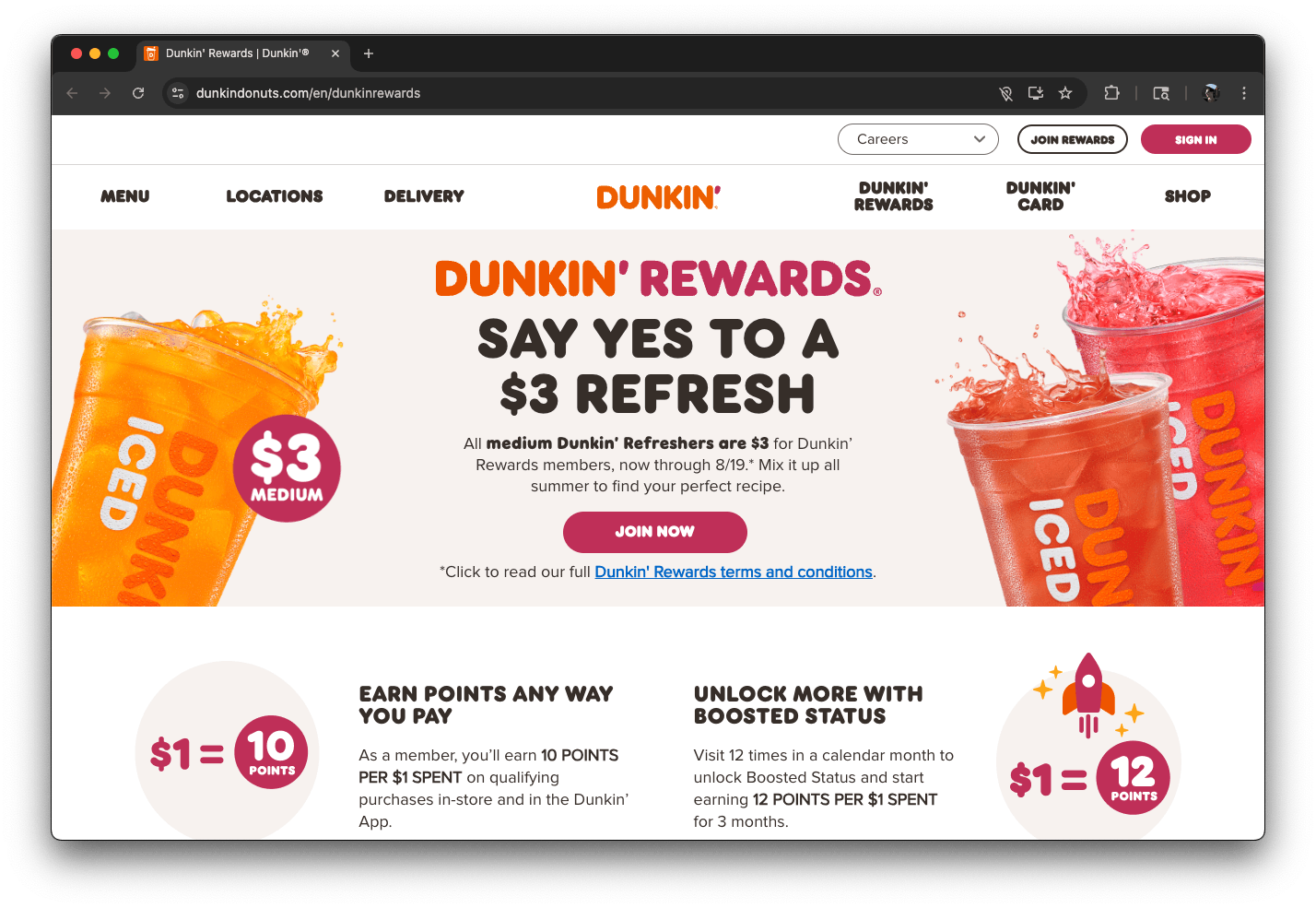
In 2022, Dunkin’ replaced its older program, DD Perks, with a revamped loyalty program called Dunkin’ Rewards.
These changes were marketed as a response to member feedback. The donut chain made it easier to collect points and redeem them for rewards beyond just drinks. Customers can now use points to score free treats, from donut holes to everything bagels.
What makes it work:
Expanded redemption options. Customers can now use points for a wider variety of menu items, not just drinks, which appeals to more people.
Familiarity and routine. With a large, loyal customer base that visits frequently, the program taps into daily habits that naturally generate points and engagement.
Digital integration. The Dunkin’ app makes it easy to earn and redeem points while also driving mobile orders and customer data collection.
Best for:
Brands in the quick-service food and beverage industry that want to drive frequent purchases and mobile app engagement.
Key takeaway:
Loyalty program changes should be grounded in customer preferences, transparency, and benefits.
5. Hilton
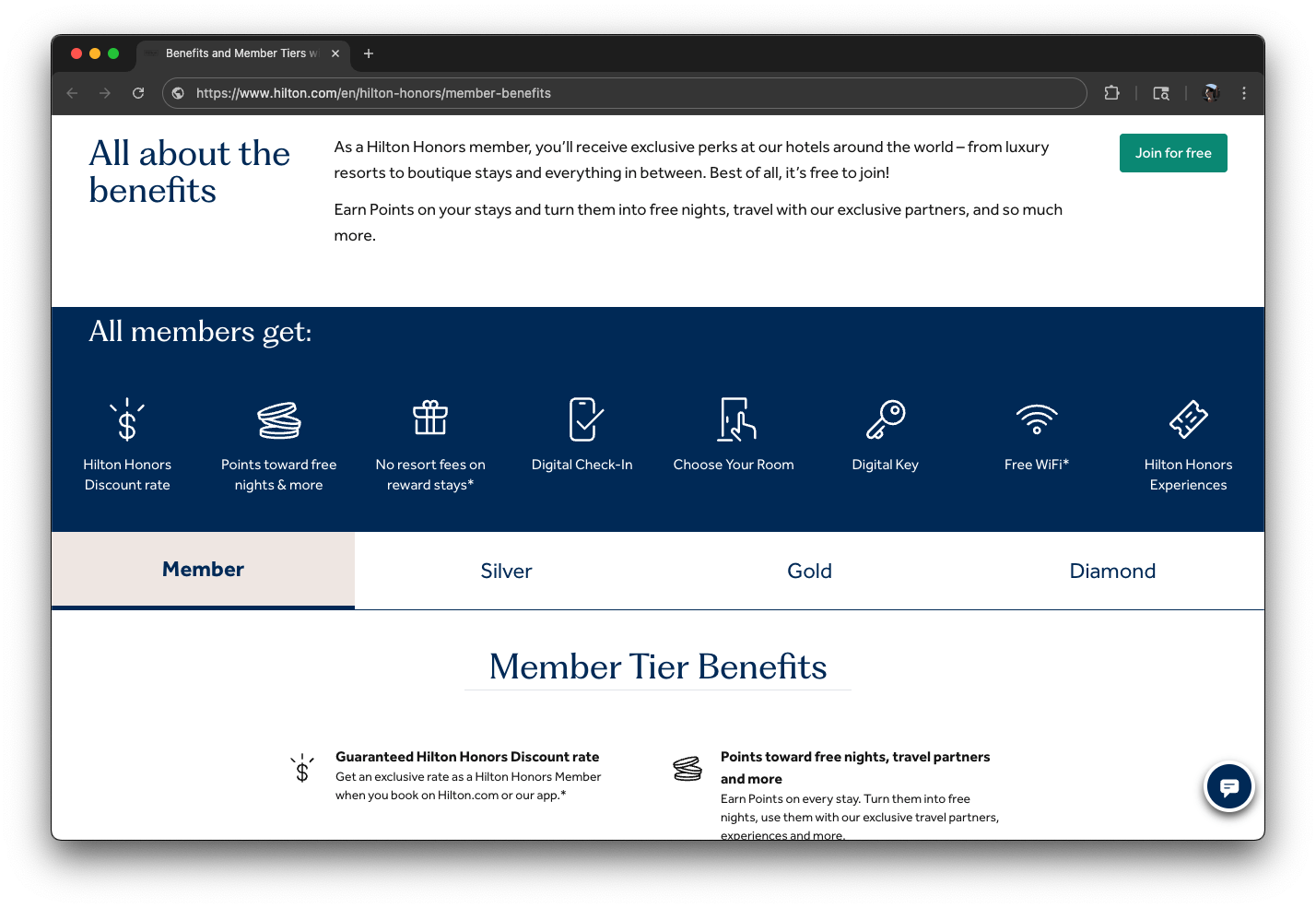
Hilton Honors Members earn points on hotel stays, Lyft rides, Hilton-branded credit cards, and dining. They can also purchase points.
Guests who join Hilton Honors get guaranteed lowest prices on rooms, free Wi-Fi, and points to book free hotel stays.
The program has four tiers: Member (0-10 nights), Silver (10+ nights), Gold (40+ nights), and Diamond (a whopping 60+ nights). Perks get better the more nights members book with Hilton.
What makes it work:
Robust tiered structure. The four-tier system drives loyalty by offering escalating perks, from free Wi-Fi to executive lounge access.
Multiple earning pathways. Members earn points not just through hotel stays but also credit card spending, Lyft rides, and dining.
Real, high-value rewards. Points can be redeemed for tangible rewards like hotel stays — a compelling offer for frequent travelers.
Best for:
Brands in hospitality, travel, or lifestyle services that want to build long-term relationships with high-value customers.
Key takeaway:
A well-structured tiered program can turn routine bookings into brand allegiance, especially as perks increase with each tier.
6. Decathlon
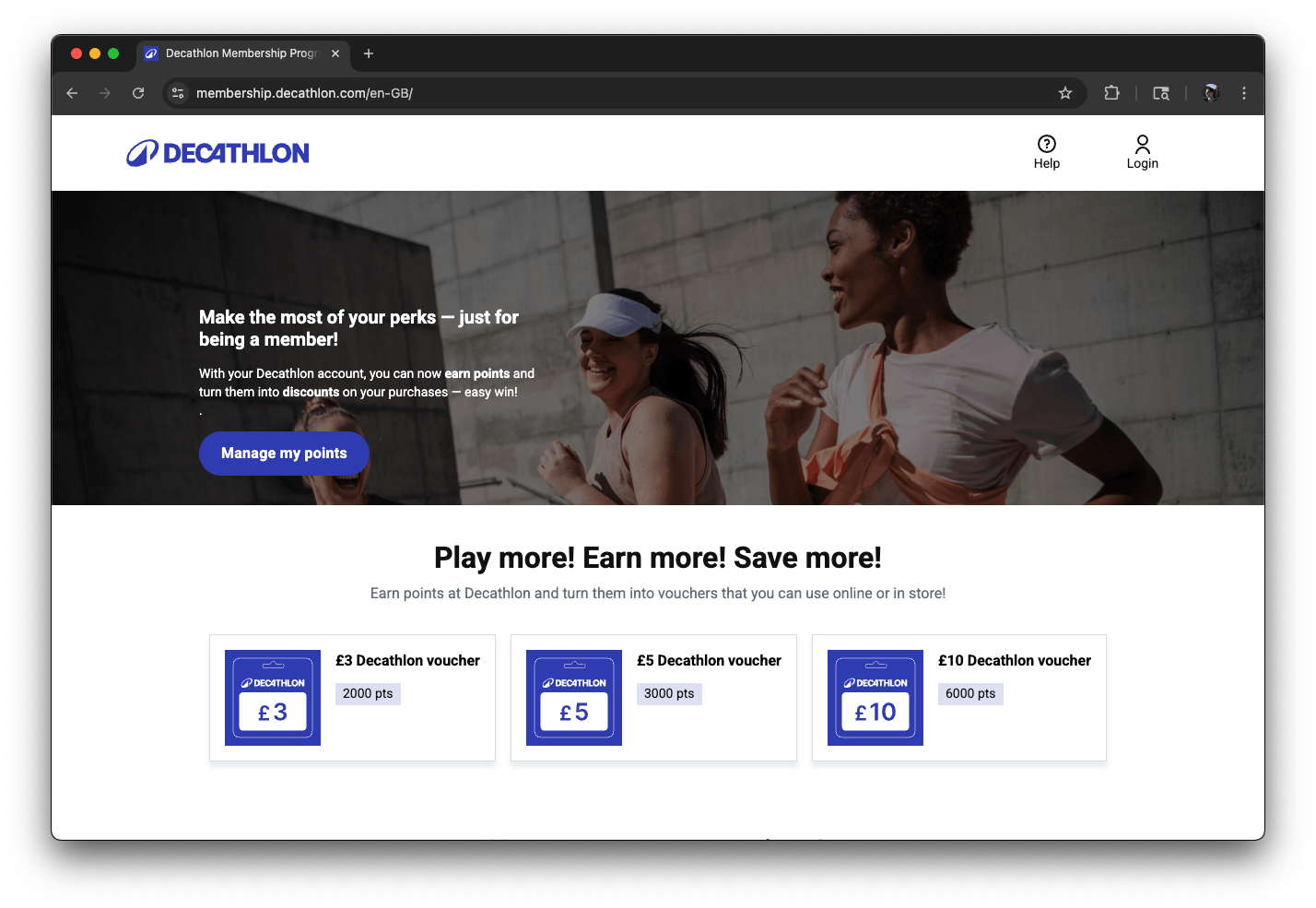
Based in France, Decathlon is one of the largest sporting goods retailers in the world with over 1,700 stores in 60+ countries. In 2021, it launched a free points-based customer loyalty program.
Originally, the program was only in Decathlon’s UK stores. As of 2025, the rewards program has been rolled out in 40 countries.
In the UK, loyalty program members earn 10 points for each £1 spent, plus:
1,000 welcome points
Up to 150 weekly points for logging 150 minutes of active time
Bonus points for reviewing products or services, with 1 review earning 100 points
In return, members get a:
£3 voucher for 2,000 points
£5 voucher for 3,000 points
£10 voucher for 6,000 points
The loyalty program is working well, driving incremental purchases, helping the Decathlon team track customer lifetime value (CLV) and annual revenue per user (RPU), and maintaining a healthy burn rate of 45 to 50%.
What makes it work:
Omnichannel integration. The program captures data from Decathlon’s physical stores, app, and website. It also integrates with fitness apps to offer points for being active.
Value goes beyond transactions. Members can earn meaningful points from non-transactional activities like writing reviews or exercising.
Elements of gamification. Offering extra points for different actions helps gamify the program, especially with recurring activities like working out.
Best for:
Retailers with large physical footprints that want to increase digital engagement, reinforce their brand values, and gain deep customer insights.
Key takeaway:
Loyalty programs that reward both lifestyle actions and purchases can drive better engagement.
Membership-based rewards programs
7. Nike
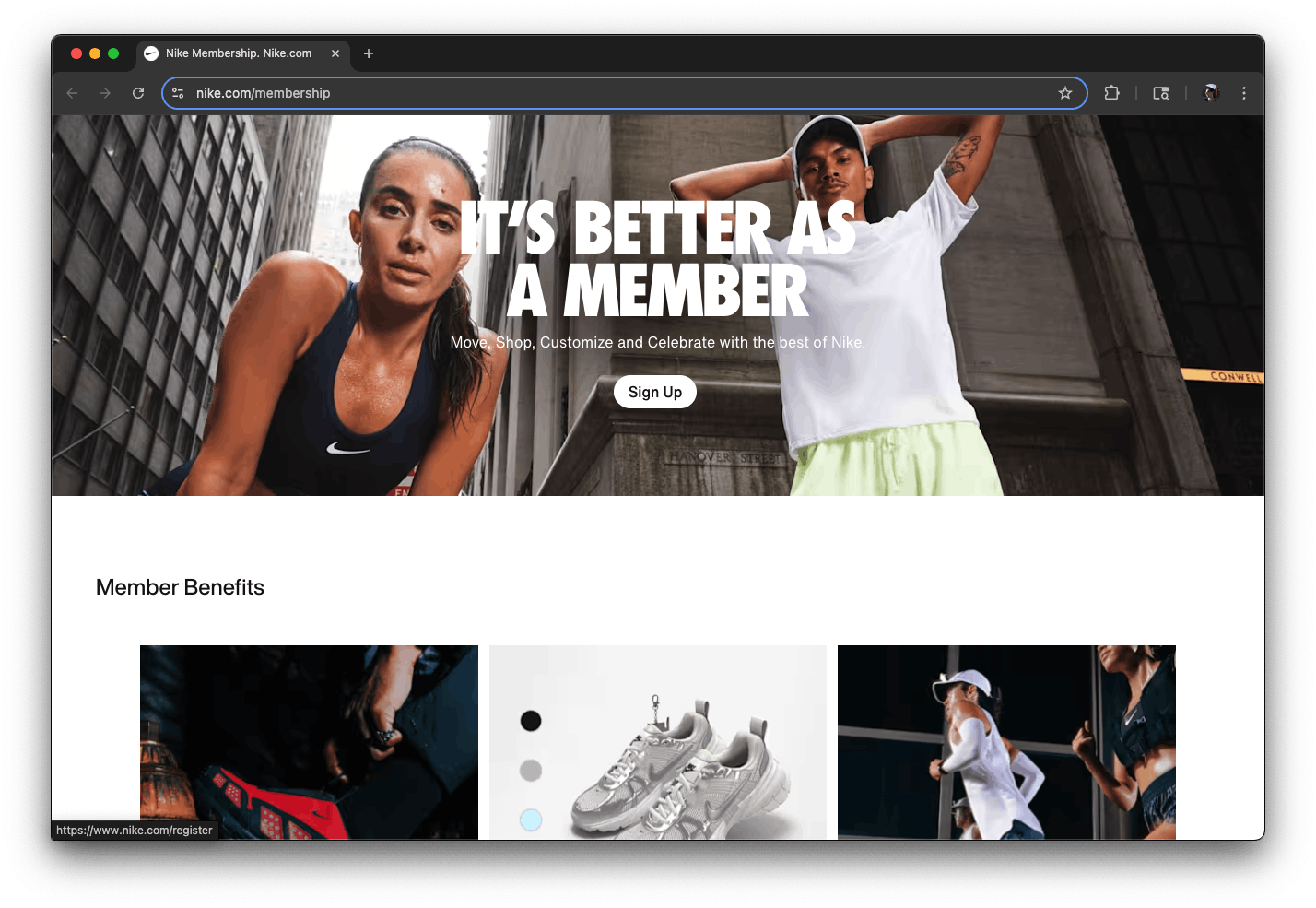
Nike’s loyalty rewards program doesn’t give customers points. Instead, members sign up for free to access exclusive benefits like free shipping, 60-day wear tests, and receiptless returns through the Nike mobile app. 300 million members make repeat purchases via digital and physical retail outlets.
According to former Nike CEO John Donahoe, the loyalty program creates "meaningful direct lifelong relationships with consumers" and was the top reason its digital business grew 34% in Q2 2022.
What makes it work:
Experience over points. Nike focuses on access and convenience instead of points, making it easy for consumers to reap program benefits immediately.
Omnichannel engagement. Members shop seamlessly across Nike’s app, website, and physical stores, with unified benefits and a frictionless experience.
Brand-aligned value. Nike reinforces its identity by rewarding loyal customers with insider perks and community access as well as discounts.
Best for:
Lifestyle and direct-to-consumer (DTC) brands that want to build strong emotional relationships and drive engagement.
Key takeaway:
When loyalty rewards align with your brand promise and improve the customer experience, you can create lasting relationships that drive growth.
8. CVS
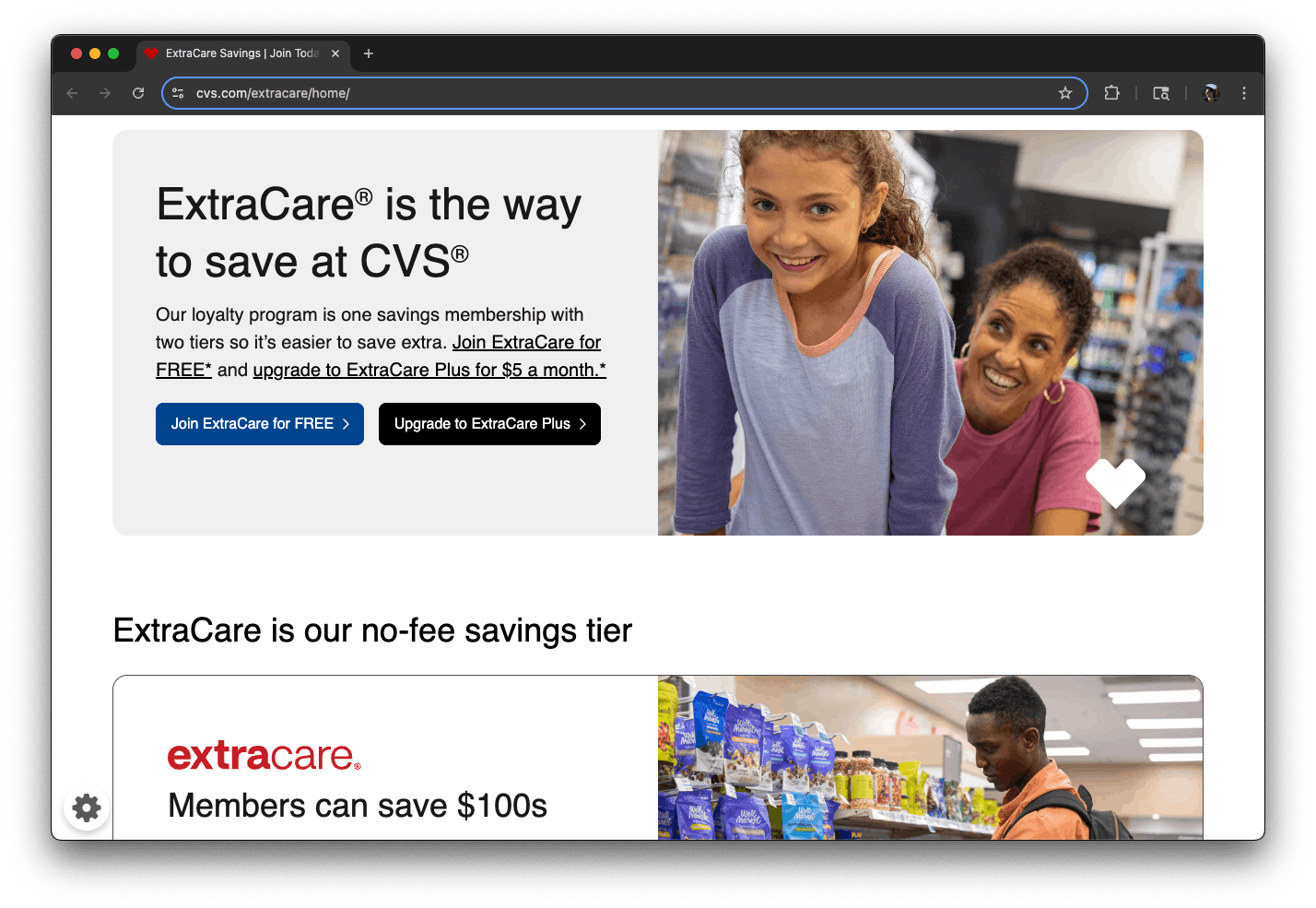
CVS ExtraCare membership gives customers access to sales prices and rewards for purchases, prescriptions, and vaccinations. With more than 74 million members, CVS ExtraCare is one of the most popular loyalty programs in North America.
CVS employs a freemium model. Its basic offering is free, while a paid ExtraCare Plus membership unlocks additional benefits like free same-day delivery, free shipping, 20% off CVS Health brand products, and a $10 monthly reward. Free, basic benefits drive repeat purchases and brand loyalty, while paid membership perks create an additional revenue stream.
Best of all, customers can opt into a loyalty program that works for them. If they want more perks, they can pay for Plus. If not, they still get rewarded in the free program.
What makes it work:
Dual-option loyalty model. By offering a free and paid tier, CVS appeals to casual shoppers and committed customers alike.
Cashback simplicity. Earning 2% back in ExtraBucks makes the program easy to understand and feel instantly rewarding at checkout.
Paid tier adds convenience + savings. ExtraCare Plus offers clear, recurring benefits like $10 monthly rewards and free delivery, justifying the program fee for frequent customers.
Best for:
Retailers in healthcare, pharmacy, or essentials categories that want to drive broad adoption and recurring revenue.
Key takeaway:
Blending free and paid loyalty benefits gives customers choice, increases satisfaction, and generates revenue while keeping shoppers coming back for more.
9. Uber
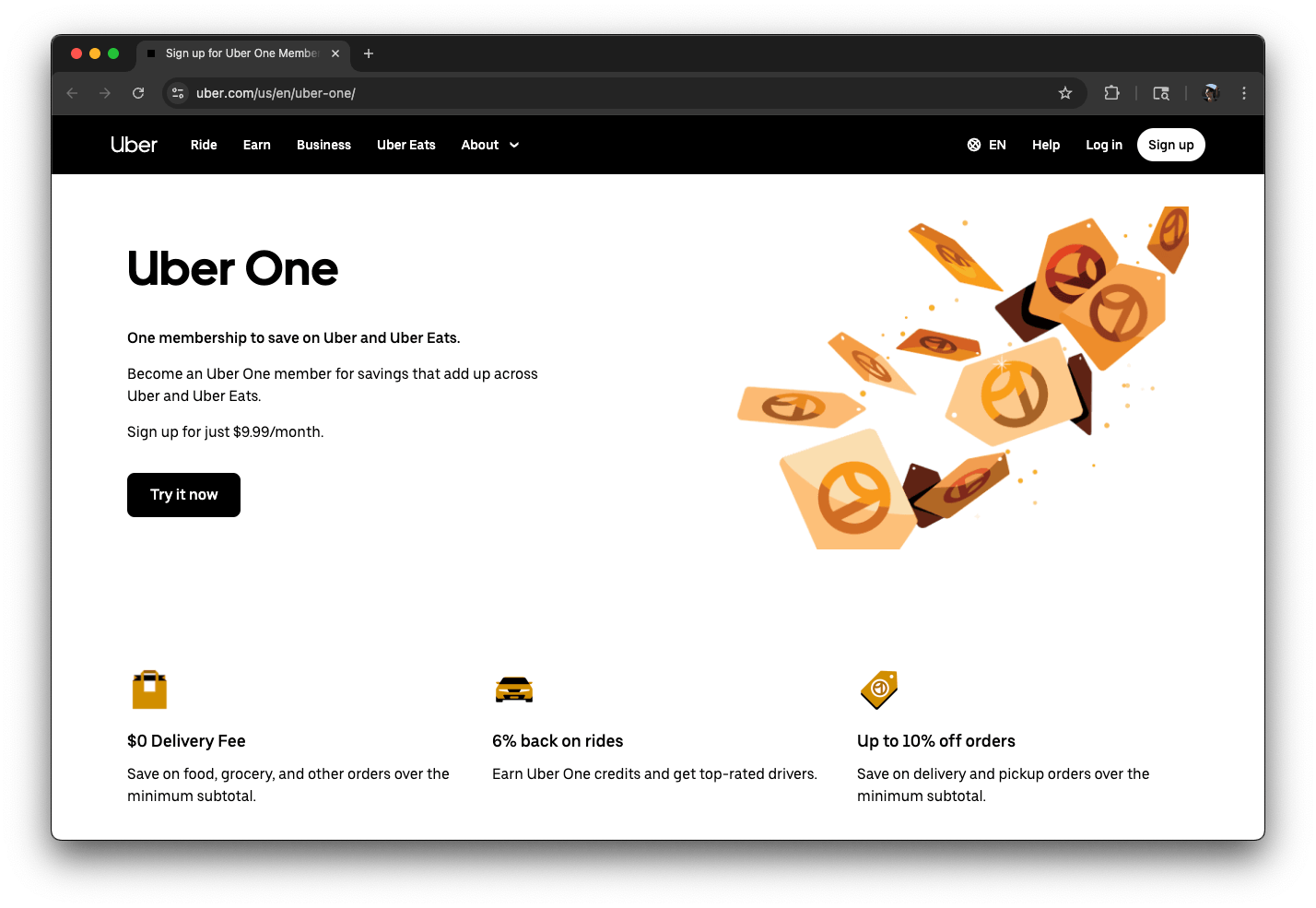
Uber is a great example of how pivoting from a free loyalty program to a paid one can pay off. In 2022, the ridesharing app sunsetted its free points-based loyalty program to focus on its premium loyalty membership, Uber One.
Uber One subscribers get free delivery on Uber Eats, up to 10% off food orders, discounted pricing for trips, 6% Uber One credits on eligible rides, and free ride cancellations for $9.99 a month. This revamp paid off: in the second quarter of 2023, 27% of gross bookings came from Uber One members.
What makes it work:
Value-packed subscription. For frequent Uber and Uber Eats customers, the $9.99/month fee quickly pays for itself with delivery savings, ride discounts, and exclusive perks.
Simplified loyalty strategy. By replacing its free program with a single paid tier, Uber streamlined the program experience and focused on high-value, high-frequency users.
Cross-service integration. Uber One rewards usage across both rides and food delivery, increasing customer engagement with Uber’s full product ecosystem.
Best for:
Service-based brands with multiple products that want to unify loyalty and increase recurring revenue across their portfolios.
Key takeaway:
A paid loyalty program can outperform traditional free models if the perks are generous, easy to use, and tied to frequently used services.
10. Costco
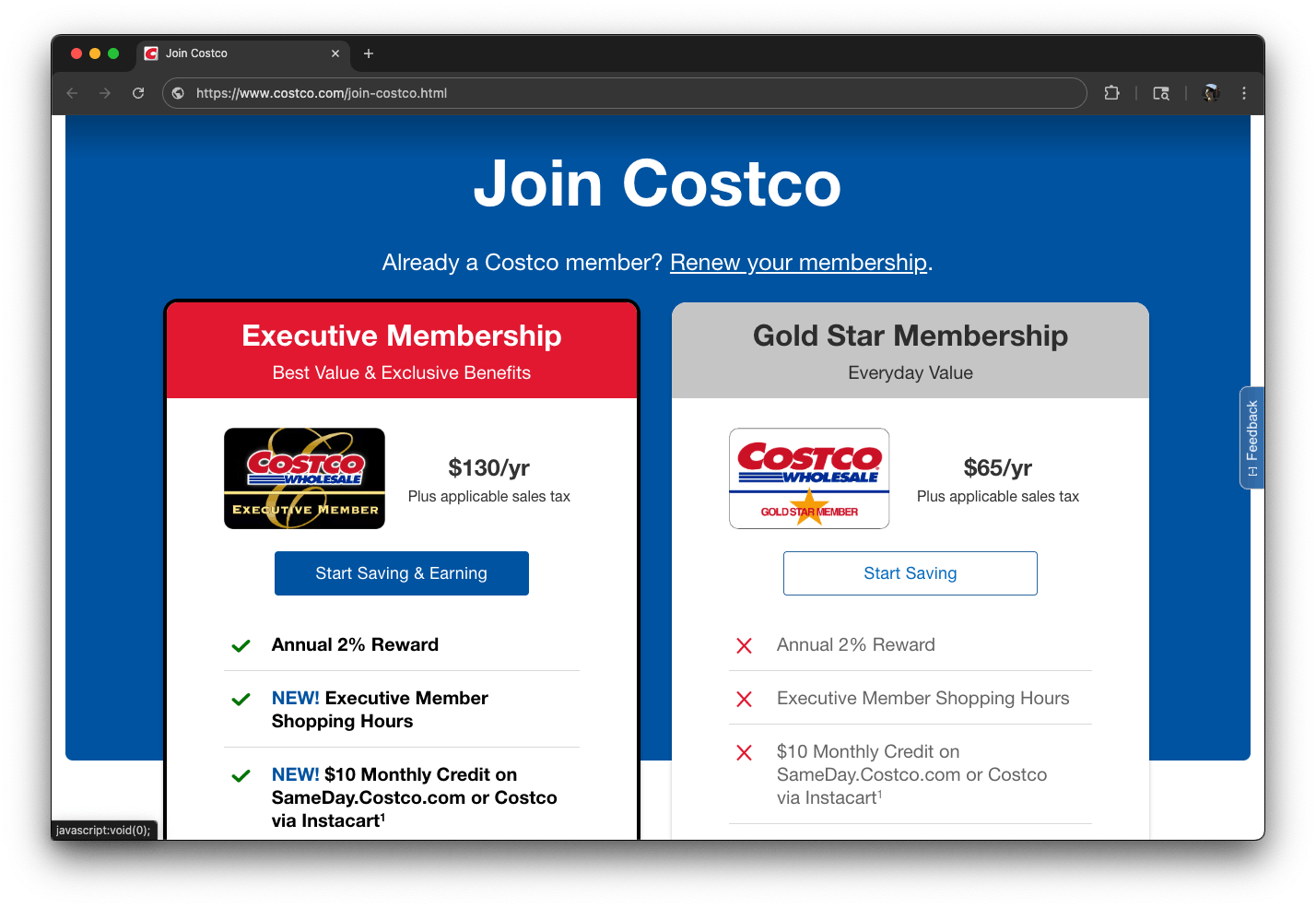
Shoppers need a loyalty membership if they want to shop at Costco and get lower prices on everything from shampoo to tires.
The warehouse giant offers two membership tiers:
Gold Star/Business: $65 a year
Shop online and in store
Get 2 membership cards
Executive: $130 a year
Everything in Gold Star/Business
Annual 2% bonus reward
Executive member-only shopping hours
$10 monthly credit on delivery services
About 80% of Costco’s gross margin comes from membership fees. That means Costco essentially operates its stores on a break-even basis to encourage membership.
And customers see the value of the program. A whopping 9 in 10 members renew every year, and Costco has topped 120 million members worldwide.
What makes it work:
Membership-first model. By requiring a paid membership, Costco creates exclusivity and builds recurring revenue directly into its business model.
Clear value proposition. Executive members get a straightforward 2% back annually, more than paying for the entire membership fee for frequent shoppers.
Operational strategy reinforces loyalty. With most of its profit coming from memberships, Costco can keep prices low and members coming back.
Best for:
Subscription retailers and volume-based sellers looking to build loyalty through upfront commitment and ongoing value.
Key takeaway:
When loyalty program savings are real and consistent, customers will stick around for years.
11. Amazon
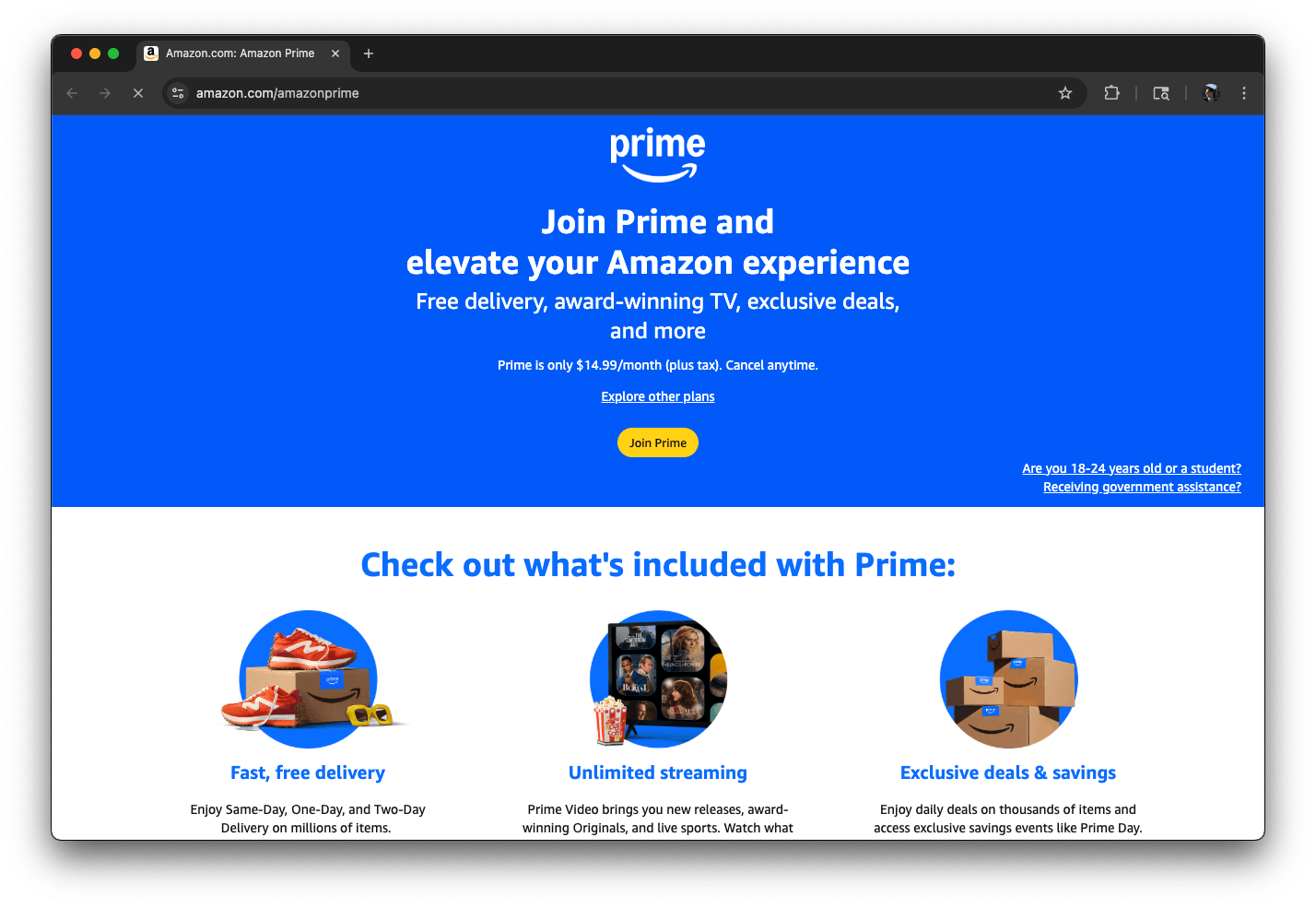
With over 200 million members, Amazon Prime is one of the most powerful loyalty programs in the world. Members receive free shipping, exclusive deals, and access to Prime Video, Music, and Reading. This suite of benefits creates an "everything membership" that keeps users in Amazon’s ecosystem.
In Q1 2025, Amazon reported $11.2 billion in revenue from subscription services, including Prime.
What makes it work:
Massive bundled value. Prime combines shopping, entertainment, and convenience in a single subscription that offers something for everyone.
Frictionless repeat behavior. Free shipping and fast delivery remove friction points and drive frequent new orders.
Habit-forming engagement. With streaming services, eBooks and audiobooks, and Alexa services, Prime stays relevant daily, not just when you're shopping.
Best for:
Large e-commerce, marketplace, and multi-service platforms looking to bundle value across verticals and embed their brands into consumers' daily routines.
Key takeaway:
By offering value across commerce, content, and services, Amazon turns loyalty into habit and habit into revenue.
Innovative and hybrid programs
12. Microsoft Rewards
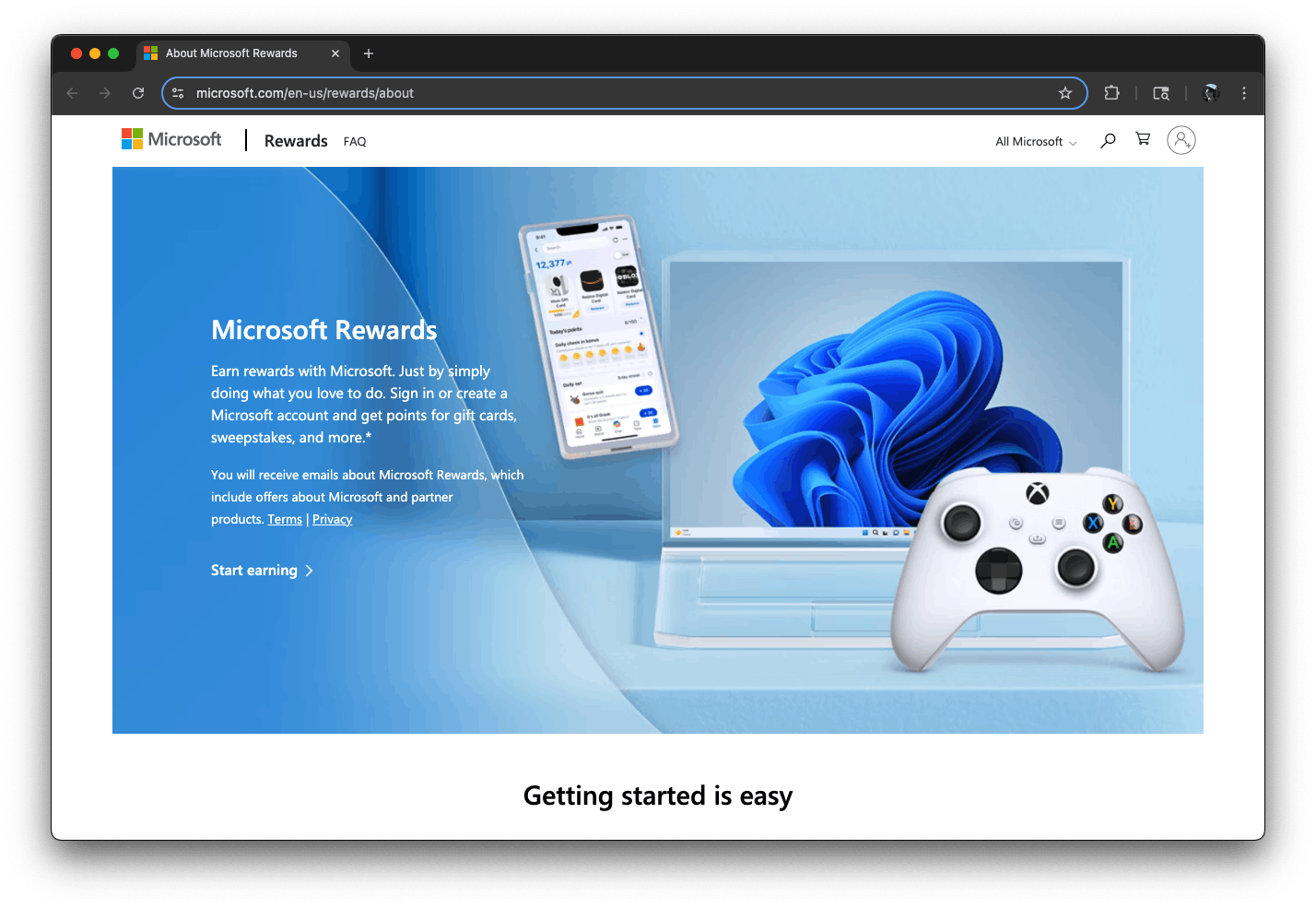
Microsoft Rewards is a free, tiered points-based loyalty program that spans Bing, Xbox, and the Microsoft Store.
Members earn points by searching with Bing, browsing in Microsoft Edge, playing games on Xbox, and shopping in the Microsoft Store. They can also complete daily quizzes, polls, and challenges on a personalized dashboard.
With two status levels, members can unlock increasing earning rates and exclusive offers as they advance. Level 2 users can earn up to 600 points a month just from search.
Members get access to a wide range of rewards, including:
Gift cards
Sweepstakes entries
Subscriptions to services like Spotify Premium
Donations to charity
Xbox credits
This loyalty program is popular. The Microsoft Rewards subreddit has 152K members around the globe and is in the top 2% of subreddits.
What makes it work:
Tiered structure. Microsoft Rewards incentivizes consistent engagement on both tiers.
Multi-channel earning. The program successfully brings together several channels and uses them to gamify everyday digital activities.
Personalization. Members get a dashboard with personalized quests and challenges, and Microsoft gets granular information to support smarter audience targeting.
Best for:
Brands with omnichannel platforms that span multiple consumer offerings.
Key takeaway:
Building loyalty through frequent, low-barrier activities leads to consistent engagement and new purchases.
13. Boots Scan2Recycle
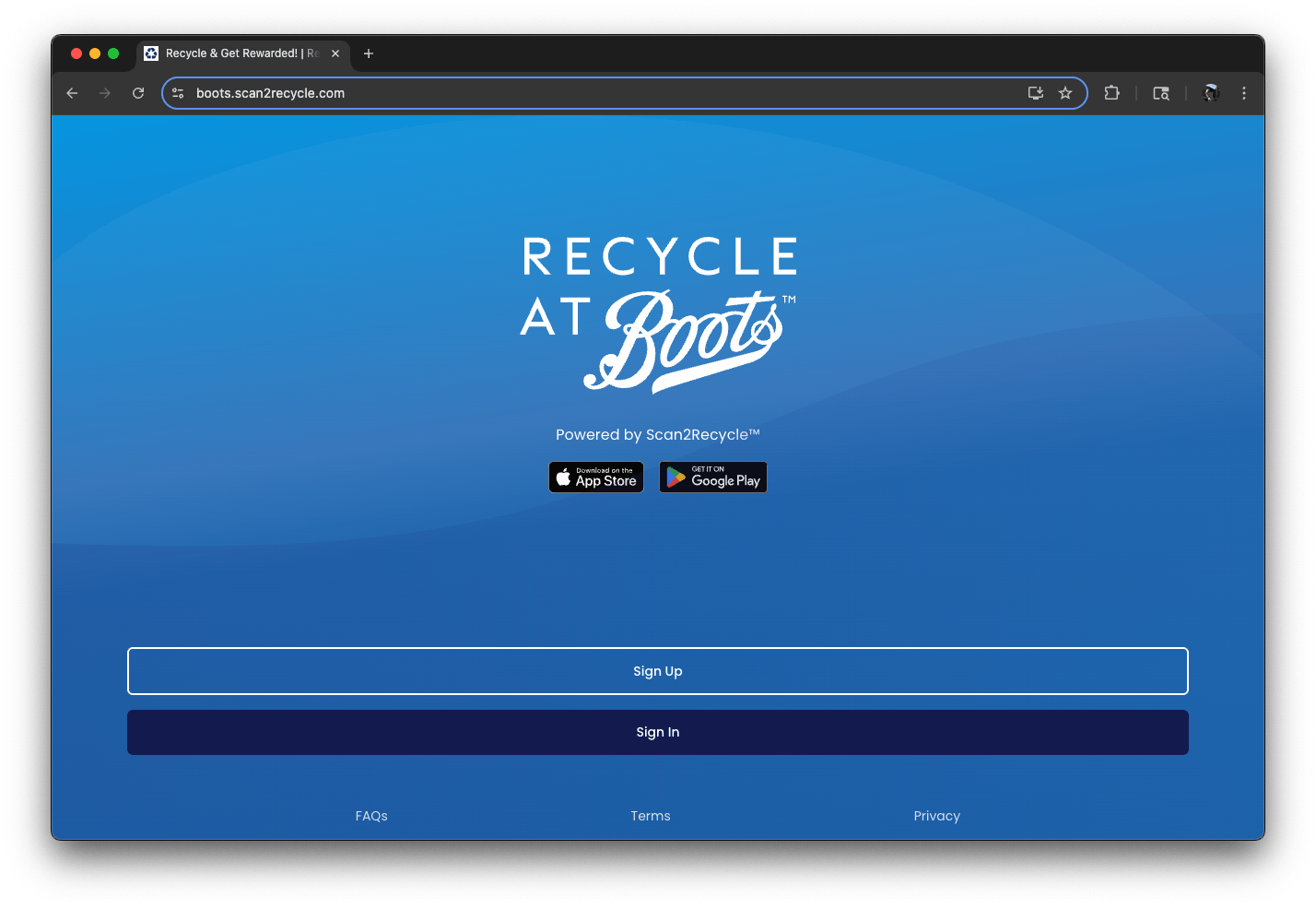
Boots is a leading UK health and beauty retailer with an admirable recycling initiative tied to its Advantage Card program. Launched in 2020, Recycle at Boots rewards shoppers with Advantage Card points.
The best part? The program only accepts hard-to-recycle items like toothpaste tubes, floss dispensers, and eyeshadow palettes.
Customers label and verify their items, then deposit them at a nearby Boots store. Once users drop off items, they get a reward voucher for 500 points (equivalent to £5) if they spend £10 or more in Health, Beauty, and Wellness purchases or £5 in Blister Packs within three days.
From there, customers can save points up to buy something bigger or spend them right away.
What makes it work:
Behavior-based rewards. Rewards are only unlocked when customers drop off recyclable items and make a purchase, benefitting the environment and their bottom line.
Strong program incentives. Customers can only participate in the recycling program if they have a free Boots Advantage Card, driving signups.
Tangible value. 500 points (worth £5) is a meaningful incentive, especially combined with other Boots Advantage Card points to buy bigger-ticket items.
Best for:
Retailers in health, beauty, or consumer goods sectors that want to promote sustainability and drive foot traffic.
Key takeaway:
By rewarding eco-friendly actions with usable loyalty points, customers get rewarded for recycling while the brand earns repeat visits and purchases.
14. Book of the Month
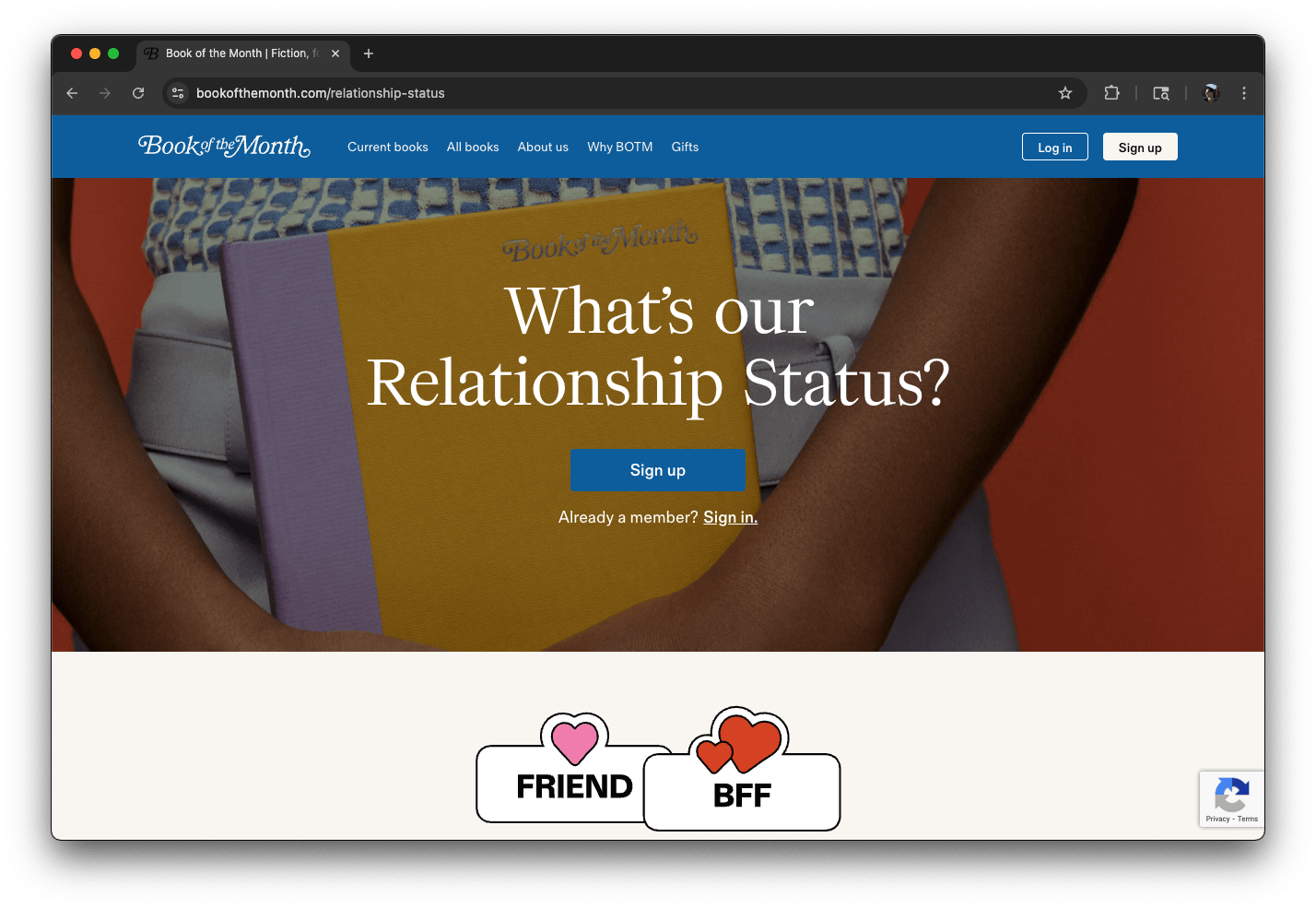
Book of the Month is a popular subscription box service that curates and sends out branded hardcovers to members every month. It also has a rewards program called Relationship Status — proof that subscription services can foster even deeper loyalty with customers.
The program is fairly simple. Once users have three books delivered during their membership, they become a Friend. After 12 books, they reach BFF status. Skipping a month or pausing the membership doesn’t negatively affect members’ progress unless they don’t resume regular shipments within 30 days.
Here’s what members get for each relationship tier:
Friend: $5 savings on add-ons, free shipping of up to 5 books a month, and the ability to vote for the Book of the Year.
BFF: Everything a Friend gets, plus a BOTM tote bag, free birthday book credit, free Book of the Year, and priority service through the BFF hotline.
Users don’t have to do anything extra or special to gain status. And in return, they get discounts, fun swag, and free books.
What makes it work:
Seamless integration. Members don’t need to take extra actions to earn loyalty program status as long as they stay subscribed.
Emotional branding. Using playful tiers like Friend and BFF taps into part of an in-group.
Tangible rewards at smart milestones. Key loyalty moments are celebrated with meaningful perks like discounts, exclusive items, and free books.
Best for:
Subscription-based businesses aiming to increase retention and lifetime value.
Key takeaway:
A simple, stress-free loyalty program works well to reward subscribers who stick with your brand for the long run.
15. Rakuten Point Card
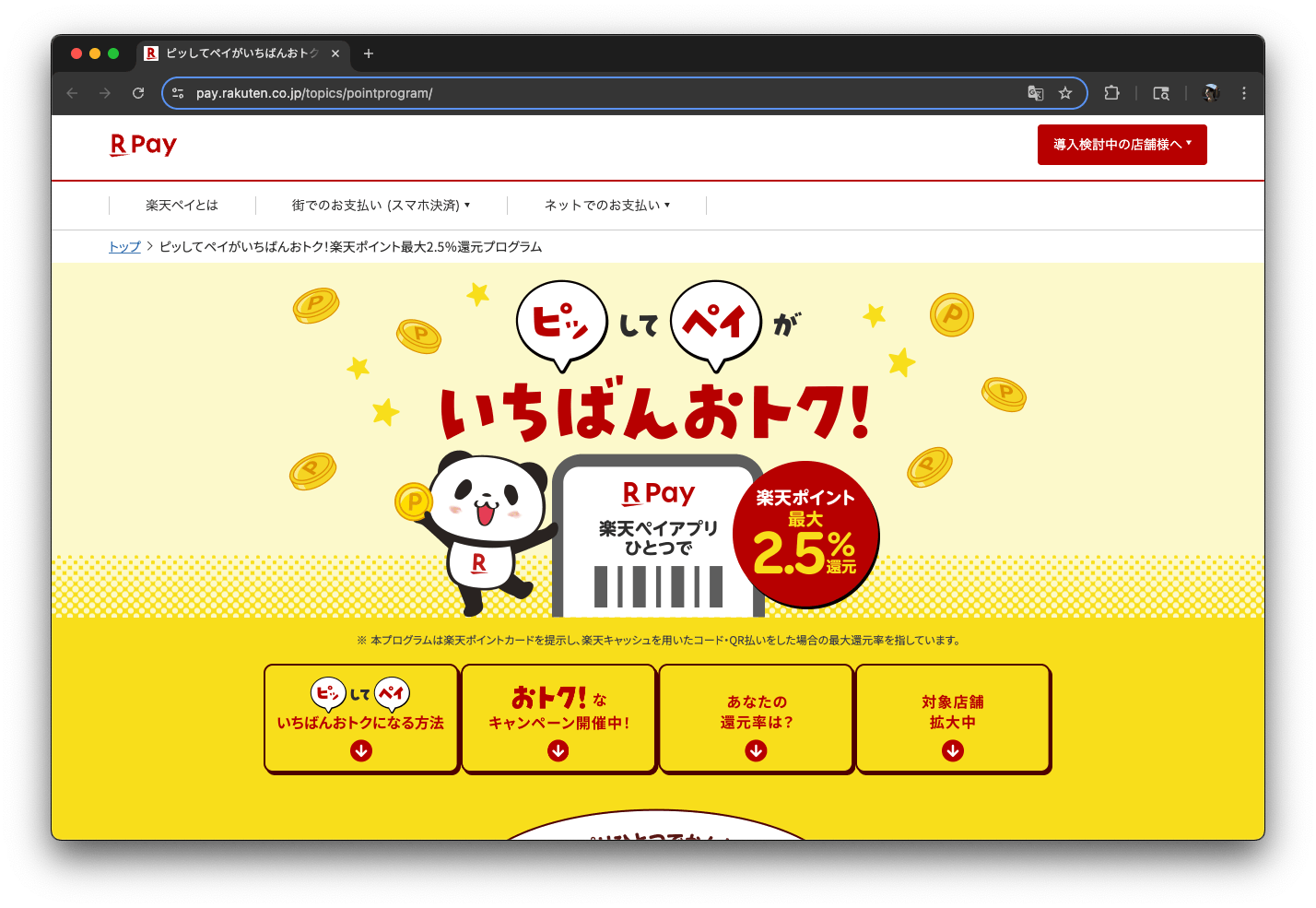
Rakuten Point Card is Japan’s ubiquitous loyalty program that seamlessly combines physical and digital spending. It works across convenience stores, gas stations, supermarkets, and Rakuten’s own vast ecosystem (e.g., Ichiba e‑commerce, Pay, and credit card).
Users can earn points within Rakuten and third-party partner stores, and redeem points in the same way. Users can even invest Rakuten Points in the stock market.
Millions of Japanese consumers use Rakuten Points every day. In 2022, Rakuten announced it had rewarded over one trillion points.
What makes it work:
Flexible platform and wide network. Points earned online can be used offline and vice versa, increasing stickiness across Rakuten’s ecosystem.
Point-multiplying opportunities. Multipliers reward customers who use multiple Rakuten services.
Easy to earn points. Members earn points through everyday tasks like buying gas, paying credit card bills, and shopping at convenience stores.
This loyalty program example is best for:
Brands looking to drive repeat purchases across diverse products and services.
Key takeaway:
By weaving loyalty into everyday activities and rewarding deeper ecosystem use, brands can drive high engagement, increase cross-selling, and claim a dominant market position.
Loyalty rewards programs pay off when done right
Whether you’re starting or scaling your loyalty program, these 15 successful loyalty program examples can inspire your next steps. Across programs, brands are driving success with the following tactics:
It’s free to join at a basic membership level.
There’s a mobile app for convenience.
They offer an elite loyalty tier for top customers.
They give members meaningful monetary rewards like cashback, product discounts, or gift cards.


